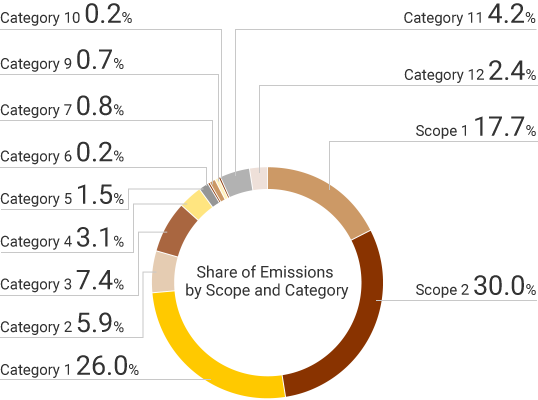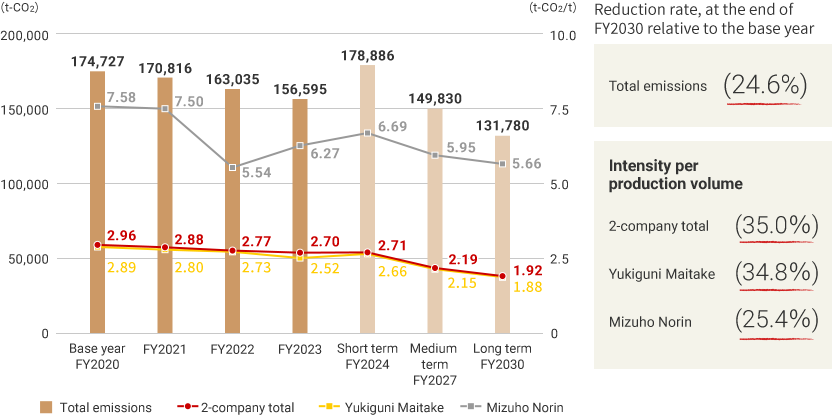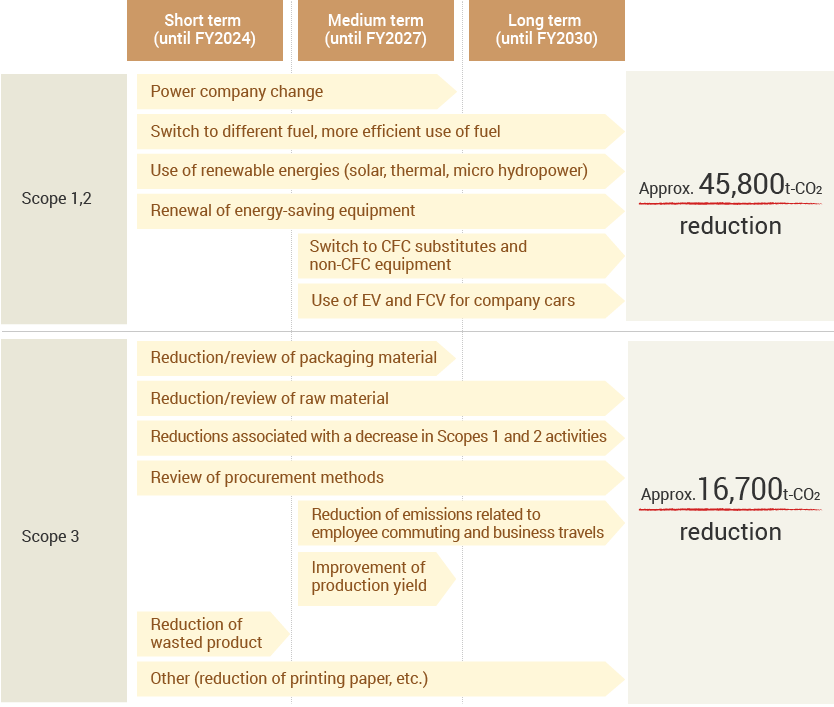Policies and Strategies
Climate change is caused by global warming and it is expected to give rise to abnormal weather and natural disaster. Therefore, the entire international society must unify to address this issue. In 2015, the 21st Conference of the Parties to the United Nations Framework Convention on Climate Change (COP21) was held in Paris and the Paris Agreement was adopted. In it, a global long-term goal of “limiting global warming to well below 2, preferably to 1.5 degrees Celsius, compared to pre-industrial levels” was announced.
Also, climate change is also likely to affect the Yukiguni Maitake Group’s business through a price increase in crude oil and raw materials. For these reasons, we will commit to the reduction of greenhouse gas (GHG) emissions with an understanding that addressing climate change is a critical issue for the sustainability of the world and our Group.
Therefore, the Group has set the targets of “achieving net zero GHG emissions” in FY2025 and “reducing the emission intensity (production based) by 35% from FY2020 level by FY2030,” and have identified “response to climate change” as our materiality. Thus, we are working to “mitigate climate change” (reduce GHG emissions) throughout our value chain from procurement to production, logistics, and distribution. We are making efforts to reduce our environmental impact by using alternative energy sources with high energy conversion efficiency, reducing the volume of plastic materials for mushroom products by reviewing packaging forms and materials, and reducing CO2 emissions in logistics by procuring raw materials from local areas. In addition, in order to “adapt to climate change, we have identified “procurement of raw materials and use of water resources in a sustainable way” as our materiality and will promote initiatives such as the “Yukiguni Maitake Forest Creation Activities,” which is our forest maintenance activities.
Furthermore, in November 2021, Yukiguni Maitake announced its support for the Task Force on Climate-Related Financial Disclosures (TCFD) recommendations, which call for appropriate disclosure of information on the financial impact of climate change. We are identifying risks and opportunities due to climate change, assessing their significance, and estimating their financial impacts based on the 1.5°C and 4°C scenarios. With our support for the TCFD recommendations, we will further accelerate our efforts to realize a decarbonized society and disclose information in line with the TCFD recommendations.
Structure, Governance and Risk Management
Sustainability Management Structure
For details, please see Sustainability Management Structure
Indicators and Targets
We measure GHG emissions for Scope 1, 2 & 3 at the Yukiguni Maitake Group,as part of our efforts to mitigate climate change. We chose FY2020 as the base year and set our reduction targets for FY2030 and FY2050. For FY2030, we aim to reduce the emission intensity (production based) by 35% from the base year. In addition, with the ultimate target of “net zero emissions” in FY2050, we will work to reduce greenhouse gas emission throughout our value chain from procurement to production, logistics, and distribution.
| Scope | Unit | FY2020 (Base year) |
FY2021 | FY2022 | FY2023 | Target | |
|---|---|---|---|---|---|---|---|
| GHG gas emissions (Scope 1, 2 & 3) | Consolidated | t-CO2 | 174,727 | 170,816 | 163,035 | 156,595 | *1 |
| Scope 1 | Consolidated | t-CO2 | 30,184 | 30,768 | 28,277 | 27,705 | - |
| Scope 2 | Consolidated | t-CO2 | 53,620 | 54,755 | 48,489 | 46,971 | - |
| Scope 3 | Consolidated | t-CO2 | 90,923 | 85,293 | 86,270 | 81,920 | - |
| Emission intensity (Production based) | Consolidated | t-CO2 | 2.96 | 2.88 | 2.77 | 2.70 | *2 |
| Total energy consumption (crude petroleum equivalent) | Consolidated | kl | 134,046,029 | 121,301,789 | 121,335,842 | 121,862,765 | - |
- *1. FY2030: Reduction of the emission intensity (production based) by 35% from the base year
FY2050: Net zero GHG emissions - *2. FY2025: 2.71 t-CO2/t
FY2030: 1.92t-CO2/t
GHG Emissions by Scope (FY2023)

| Scope/Category | Emissions (t-CO2) |
Percentage | |||
|---|---|---|---|---|---|
| Scope 3 | Scopes 1 to 3 | ||||
| Emissions from supply chain | 156,595 | 100 | |||
| Scope 1 | 27,705 | 17.7 | |||
| Scope 2 | 46,971 | 30.0 | |||
| Category 1 | Purchased products and services | 40,694 | 49.7 | 26.0 | |
| Category 2 | Capital goods | 9,188 | 11.2 | 5.9 | |
| Category 3 | Fuel- and energy-related activities not included in Scopes 1 and 2 | 11,622 | 14.2 | 7.4 | |
| Category 4 | Fuel for upstream transportation and distribution | 4,864 | 5.9 | 3.1 | |
| Category 5 | Waste generated in operations | 2,422 | 3.0 | 1.5 | |
| Category 6 | Business travel | 301 | 0.4 | 0.2 | |
| Category 7 | Employee commuting | 1,219 | 1.5 | 0.8 | |
| Category 8 | Upstream leased assets | 0 | 0.0 | 0.0 | |
| Category 9 | Fuel for downstream transportation and distribution | 1,058 | 1.3 | 0.7 | |
| Category 10 | Processing of sold products | 273 | 0.3 | 0.2 | |
| Category 11 | Use of sold products | 6,501 | 7.9 | 4.2 | |
| Category 12 | Disposal of sold products | 3,777 | 4.6 | 2.4 | |
| Category 13 | Downstream leased assets | 0 | 0.0 | 0.0 | |
| Category 14 | Franchises | 0 | 0.0 | 0.0 | |
| Category 15 | Investments | 0 | 0.0 | 0.0 | |
| Scope 3 | 81,920 | 100 | 52.3 | ||
- * Covered entities: Yukiguni Maitake and Mizuho Norin
- * Emission factors from IDEA (Inventory Database for Environmental Analysis) and the Ministry of the Environment were used. If no database exists, scenarios were created for calculation.
GHG Emissions Reduction Target

- * Currently, emissions from overseas subsidiaries are not included in the greenhouse gas calculation reduction targets.
Initiatives
Assessing the significance of risks and opportunities due to climate change
Climate change associated with global warming may cause various damages to the environment of vegetation, such as an increase in torrential rains and typhoons, as well as floods, landslides, intense heat, and abnormally warm winters and cool summers caused by abnormal weather. In the Yukiguni Maitake Group, climate change on a global scale may also affect our business and finances, such as rise in raw material prices due to soaring crude oil prices and changes in consumer preferences.
Based on these thoughts, Yukiguni Maitake conducted a scenario analysis by setting the year 2030 as the target year. In our scenario analysis, we considered two scenarios: a 1.5°C scenario in which the transition to a decarbonized society progresses, and a 4°C scenario in which no measures that exceed current measures are taken to prevent global warming and global warming progresses. In considering the scenarios, we referred to the scenarios in the World Energy Outlook published by the IEA, the scenarios in SSP (Shared Socio-Economic Pathway) and RCP (Representative Concentration Pathway) adopted by the IPCC, and various future projections and plans published by the Japanese government and others.
The risks and opportunities currently assumed are as follows.
| Classification | Event | Anticipated Impact on Business | Expression period | Importance | Measures | |
|---|---|---|---|---|---|---|
| Transition risk | Policy | Introduction of carbon tax | Increased carbon tax burden on CO2 emissions from production, logistics, and other business activities | Short Mid & Long |
Large |
|
| Increased procurement costs for plastic packaging materials | Short Mid & Long |
Small |
|
|||
| Physical risk | Acute | Intensification and frequency of extreme weather events such as typhoons, heavy rains, and heat waves | Natural disasters and extreme weather conditions destabilize the procurement of auxiliary materials such as sawdust and bran, which are raw materials for mushroom cultivation, and their prices soar | Short Mid & Long |
Small |
|
| Chronic | Rising temperatures, fluidized precipitation and weather patterns | Rising temperatures change the growth environment of mushrooms and increase air conditioning costs for temperature and humidity control | Short | Small |
|
|
| Opportunity |
Products & Service | Development and expansion of products and services that can contribute to low carbon and decarbonization | Increasing substitution of plant-based foods for animal-based foods, creating more opportunities to create new commercial products using mushrooms | Short Mid & Long |
Large |
|
| Changing consumer preferences | Concerns about the risk of infectious diseases due to climate change have increased the need for mushrooms to help improve immunity | Short | Small |
|
||
| Resilience | Actualization of physical risks | Expanded marketing opportunities for mushrooms, a crop grown in facilities that is less susceptible to weather changes than open-field cultivation | Short | Small |
|
|
- * Fungus bed: A foundation for mushroom cultivation consisting of sawdust made from ground wood, mixed with water and nutrients such as bran (the outer husk or germ of wheat grains).
Estimate of financial impact
Among identified risks and opportunities, we have estimated the financial impact for those items with high likelihood of occurrence and importance.
1.5℃ scenario
In the 1.5°C scenario, risks and opportunities were examined based on scenarios related to the risks associated with the transition to a society in which various regulations are being introduced or strengthened in order to curb rising temperatures.
Significant risks/opportunities and financial impact
Social transition

- Introduce carbon tax and emissions trading for low-carbon
- Implementation of policies to promote low carbon emissions, including energy conservation and renewable energy promotion, and technological innovation in the energy conservation and renewable energy fields

- Growing environmental awareness and demand for environmentally friendly products and services
- Corporate environmental initiatives will be the axis of consideration for corporate investment
Climate change

- Temperature rise will be limited to 1.5°C by 2100

- Limited impact of global warming
- Purchases
- Production
- Sales/Consumption
Risks
Policy/ physical risks
Increase in procurement costs
Increase in procurement costs for raw materials, packaging materials (plastics), etc. (higher unit procurement costs, higher logistics costs, etc.)
(Financial impact: -60million yen)
Policy risks
Imposition of carbon tax
Increased costs due to imposition of carbon tax
(Financial impact: +1.4billion yen)
Opportunities
Resource efficiency/ Energy sources
Promote decarbonization initiatives
- Avoiding the imposition of a carbon tax through the installation of energy-efficient equipment and other decarbonization initiatives
(Financial impact: +0.7billion yen) - Reduction of business costs by introducing renewable energy
(Financial impact: +70million yen)
Production/ Service
Create new commercial products
Creation of new commercial products using mushrooms to meet the increasing demand for environmentally friendly products
4℃ scenario
In the 4°C scenario, risks and opportunities were examined based on physical risk scenarios in which global warming is expected to progress, extreme weather events are expected to occur, and natural disasters are expected to become more severe.
Significant risks/opportunities and financial impact
Social transition

- Carbon tax and emissions trading not yet introduced
- Technological innovations based on mass consumption and dependence on fossil fuels are advancing.

- Consumption activities continue to focus on price and quality
- Limited need for environmentally friendly products and services
Climate change

- Temperatures will rise (0.4-0.5°C above current levels in 2030)
- Concerned about increased risk of infectious diseases due to rising temperatures
- Sea level rises slowly due to global warming

- Increased frequency of extreme weather events such as extremely high temperatures and heavy rainfall
- Concerns about the severity of floods and other disasters
- Purchases
- Production
- Sales/Consumption
Risks
Acute risks
Difficulties in procuring raw materials
Unstable procurement and high procurement prices due to poor harvest of raw materials
(Financial impact: -0.2billion yen)
Chronic risks
Changes in growing environment
Increased costs to maintain mushroom quality (e.g., air conditioning costs)
(Financial impact: -10million yen)
opportunities
Resilience
Expansion of sales opportunities
Expanded opportunity for indoor-cultivated mushrooms which are less affected by climate change than outdoor-cultivated products
Roadmaps towards Our Goals
We have developed short-, medium-, and long-term roadmaps to achieve the FY2030 reduction target. By successfully implementing each program, we aim to reduce Scopes 1 and 2 emissions by approximately 45,800t-CO2 and Scope 3 emissions by approximately 16,700t-CO2. In addition, we will continue to explore and try new reduction programs using advanced technologies and innovations available in our society.

Promotion of CSR Procurement, On-site audits
Procurement
Use of by-products for culture medium
For GHG emissions reduction and efficient use of natural resource, we utilize by-products such as sawdust generated from wood processing for construction or wheat bran produced in the flour milling process. The use of by-products contributes to the emissions reduction equivalent to 18,243t-CO2*.
- * Calculated for the base year (FY2020)
- * A by-product produced in the process of making a product is called a “reminder flow.” It is not allocated in IDEA (intensity database) calculation for GHG emissions, and its use contributes to the reduction of GHG emissions.
Production
Energy savings with LED lighting and ground water
In our mushroom cultivation facilities, we are working to save energy in cultivation processes by using energy-efficient LED lights and taking advantage of abundant ground water of the snowy region to control temperature and humidity inside cultivation rooms.
Use of biomass energy
We use sawdust that worked as culture medium for cultivation as a biomass boiler fuel. We reduce the use of fossil fuel significantly through the efficient use of renewable energy source.
Switch to Liquefied Natural Gas (LNG)
We are working to switch the fuel used at our cultivation facilities to liquefied natural gas (LNG) with low GHG emissions. Following the installation of LNG satellite facilities and gas boilers at the Gosen Bio Center in January 2021, we installed them at the Bio Center 3 in October 2022. As a result, GHG emissions were reduced by 11.0% at the Bio Center 3 per production volume (for the fiscal year ended March 31, 2023 vs. previous year).
Logistics
Modal shift to railway transportation
Since 2017, we have been using railway transportation with refrigerated containers. This has contributed to 80% reduction in CO2 emissions compared to truck transportation.
Total logistics management to reduce truck deliveries
In 2021, Sales and Logistics Department was established for the total management from production to sales, inventories, and logistics to improve loading efficiency and optimize the number of trucks.
Office
Improvement of energy efficiency in head-office building
In Yukiguni Maitake’s head office in Minamiuonuma (Niigata Prefecture), renovation of the building, including a switch to LED lightings, was carried out in FY2020 to improve air conditioning efficiency. As a result, electricity consumption in the head-office building was reduced in FY2021 by 112,994kwh relative to FY2019.
We are exploring ways to improve energy efficiency in our Group companies’ offices as well.
Implementation of “Cool Biz” and “Warm Biz”
Since 2007, we have implemented a summer dress code (“Cool Biz”) and a winter dress code (“Warm Biz”) for all Group employees. Each employee can choose clothing according to room temperature all year round, including no neck ties. This helps to avoid extreme temperature settings of air conditioners and contributes to the reduction of electricity consumption in the office.
Our initiatives toward “adaptation” to climate change
The Yukiguni-Maitake Group is promoting the following initiatives to reduce the impact of climate change.
Yukiguni Maitake Forest creation activities
For details, please see Coexistence with local communities
Promotion of CSR procurement
For details, please see Supply chain management
Asses water stress,recycle water resources
For details, please see Sustainable use of water resources
